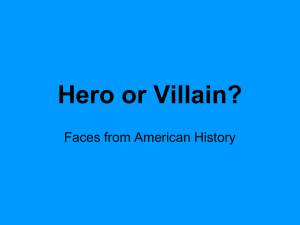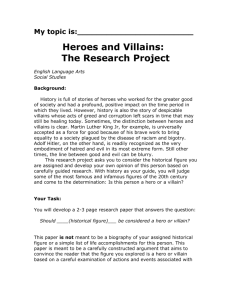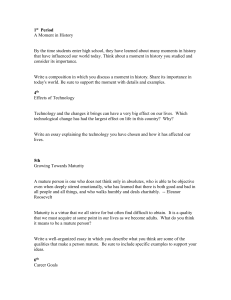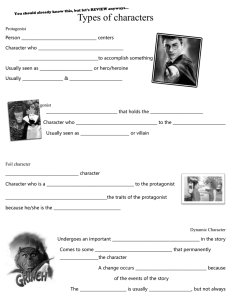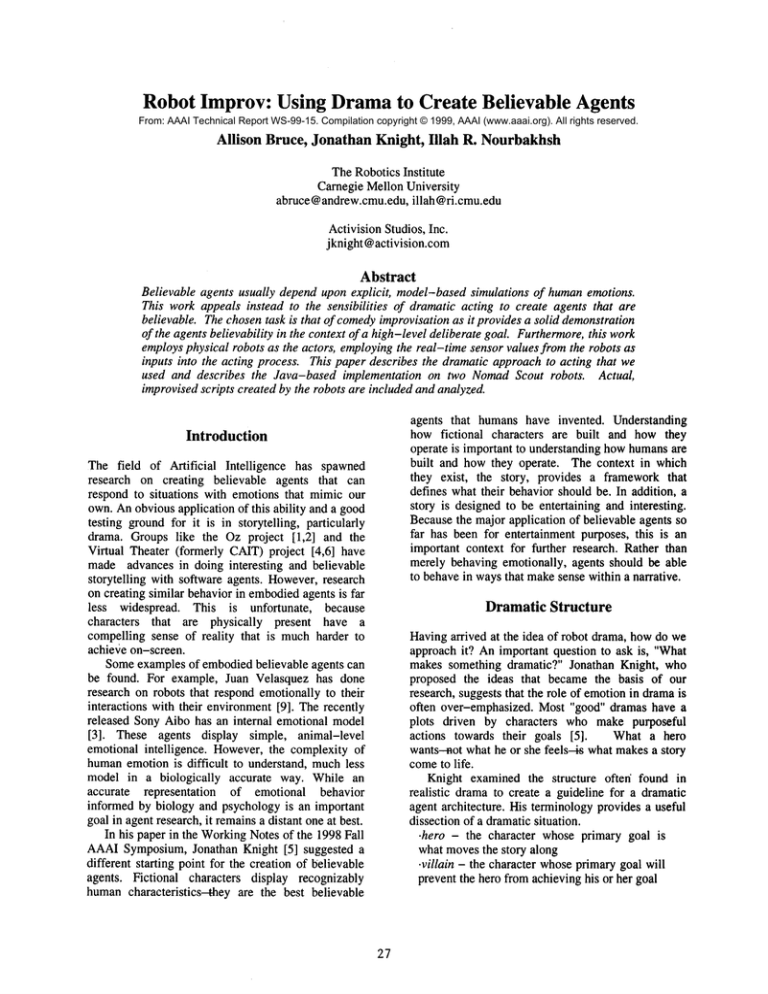
Robot Improv: Using Dramato Create Believable
Agents
From: AAAI Technical Report WS-99-15. Compilation copyright © 1999, AAAI (www.aaai.org). All rights reserved.
Allison
Bruce, Jonathan Knight,
Illah
R. Nourbakhsh
The Robotics Institute
Carnegie Mellon University
abruce @andrew.cmu.edu, illah@ri.cmu.edu
Activision Studios, Inc.
jknight @activision.com
Abstract
Believable agents usually depend upon explicit, model-based simulations of humanemotions.
This work appeals instead to the sensibilities of dramatic acting to create agents that are
believable. The chosen task is that of comedyimprovisation as it provides a solid demonstration
of the agents believability in the context of a high-level deliberate goal. Furthermore,this work
employsphysical robots as the actors, employing the real-time sensor values from the robots as
inputs into the acting process. This paper describes the dramatic approach to acting that we
used and describes the Java-based implementation on two NomadScout robots. Actual,
improvised scripts created by the robots are included and analyzed.
agents that humans have invented. Understanding
how fictional characters are built and how they
operate is important to understanding howhumansare
built and how they operate. The context in which
they exist, the story, provides a framework that
defines what their behavior should be. In addition, a
story is designed to be entertaining and interesting.
Becausethe major application of believable agents so
far has been for entertainment purposes, this is an
important context for further research. Rather than
merely behaving emotionally, agents should be able
to behave in waysthat makesense within a narrative.
Introduction
The field of Artificial Intelligence has spawned
research on creating believable agents that can
respond to situations with emotions that mimic our
own.Anobvious application of this ability and a good
testing ground for it is in storytelling, particularly
drama. Groups like the Oz project [1,2] and the
Virtual Theater (formerly CAIT)project [4,6] have
made advances in doing interesting and believable
storytelling with software agents. However,research
on creating similar behavior in embodiedagents is far
less widespread. This is unfortunate,
because
characters that are physically present have a
compelling sense of reality that is muchharder to
achiex~e on-screen.
Someexamples of embodiedbelievable agents can
be found. For example, Juan Velasquez has done
research on robots that respond emotionally to their
interactions with their environment [9]. The recently
released Sony Aibo has an internal emotional model
[3]. These agents display simple, animal-level
emotional intelligence. However, the complexity of
humanemotion is difficult to understand, muchless
model in a biologically
accurate way. While an
accurate representation
of emotional behavior
informed by biology and psychology is an important
goal in agent research, it remainsa distant one at best.
In his paper in the WorkingNotes of the 1998 Fall
AAAISymposium, Jonathan Knight [5] suggested a
different starting point for the creation of believable
agents. Fictional characters display recognizably
humancharacteristics-t-hey are the best believable
Dramatic
Structure
Havingarrived at the idea of robot drama, howdo we
approach it? An important question to ask is, "What
makes something dramatic?" Jonathan Knight, who
proposed the ideas that became the basis of our
research, suggests that the role of emotionin dramais
often over-emphasized. Most "good" dramas have a
plots driven by characters who make purposeful
actions towards their goals [5].
What a hero
wants--not what he or she feels--is what makesa story
cometo life.
Knight examined the structure often’ found in
realistic dramato create a guideline for a dramatic
agent architecture. His terminology provides a useful
dissection of a dramaticsituation.
¯ hero - the character whose primary goal is
what movesthe story along
¯ villain - the character whoseprimary goal will
prevent the hero from achieving his or her goal
27
¯ outer obstacles - external factors that prevent
the hero from achieving his or her goal
¯ inner obstacles - internal factors that prevent
the hero from achieving his or her goal
¯ given circumstances - factors that influence
how a character will attempt to achieve their
goal
A character inherits all the characteristics of a
prop because it is physically situated in the roomand
can be a goal. In addition, a character has an internal
state that holds information about its and the other
character’s past behaviors and actions, its current and
primary goals, and its inner obstacles. Eachcharacter
has a primary goal that is constant throughout the
play. It provides the character’s motivation, affecting
its inner obstacles. However, characters may have
multiple current goals at any time during the play that
it uses to evaluate potential actions. Sometimesthe
primary goal maynot even be one of the character’s
current goals.
Having robots perform a pre-scripted, complex
play (say, Hamlet) would be an obviously
unsatisfying experience. Nor would it teach us much
about how dramatic characters are structured. An
improvisation, however,by its nature, is experimental
and requires an understanding of the structure of
scenes and characters. Therefore, we implemented a
short play based on an elementary acting lesson in
whichthe two characters have conflicting goals.
Play
Room
dimensions
Props
type
l~sitton
¯ hero - A manwhowants to leave the room.
¯ villain - A womanwho doesn’t want him to
leave.
¯ outer obstacles - The villain and the door are
the hero’s only outer obstacles.
¯ inner obstacles - The emotions and attitudes
that the characters have towards each other.
¯ given circumstances - The man and the
womanboth start out in the room. There is a
painting in the roomand only one door.
Actors
Internal State
Obstacles
mention
rules
value
equilibriumvalue
decayrate
memory
cunentgoals
Behaviors
Inner
IdnslvalueObstacles]
Using this scenario as a guide, we attempted to build
an architecture that could be easily extended to allow
more complex future performances.
Actions~
Play Architecture
[
duaq
pruum7
t~as
The programarchitecture is object-oriented, allowing
plays to be created and modified quickly and easily
by changing or recombining their components (see
Fig. 1). A play is madeup of:
successfunctions
Figure 1: The O0 architecture
The inner obstacles can be thought of as the
emotionalbasis of the architecture; they are the things
that makean agent human-like, or believable. Instead
of realistically
modeling how emotions work, we
attempted to develop a flexible mechanismto specify
the factors that inhibit certain behaviors and
encourage others. We began by defining inner
obstacles for the characters as a set of basic emotions
that we thought were relevant. Frustration relates to
howwell the character thinks it is doing at achieving
its goal. Fear, empathy, and boredomrelate to how
the character interacts with the other character. Later,
we added the more abstract notions of extroversion
and trust to allow for a wider array of behavior. The
inner obstacles we chose to define for this play are by
no means the only ones that can be used. In more
complexplays, the hero mayhave inner obstacles that
the villain does not, and vice versa.
¯ the roomit is set in,
¯ props(whichare used to represent goals),
¯ characters whoperform the roles defined in the
play and have an internal state and inner obstacles
that can be biased to define their personality,
¯ the behaviors and actions available to each
character,
¯ the success functions that evaluate each character’s
progress towardits goals.
A room comprises an area of certain dimensions
within which the action of the play occurs. Points of
interest in the room(including the characters) are
defined as props, with an identifying type and a
position within the room. These props can be used to
define the characters’ goals and actions. All goals in
the play are physically based and are represented by
the prop that is the focus of the character’s attention.
28
The inner obstacles contain information about how
characters are affected not only by the other
character’s and their ownactions and behaviors, but
also by the changes in the results of their success
functions for their primary goals. These two ways of
affecting the inner obstacle are kept distinct so that
either one may be preserved or overridden when the
inner obstacle is used in different plays. In addition to
these effects, all inner obstacles have an equilibrium
value that they decay back towardat a scaleable rate.
This idea of equilibrium and decay was influenced by
Velasquez’s work on emotional models [7]. By
specifying the equilibrium values and decay rates for
a character’s
inner obstacles,
we defined the
character’s personality. A character is created with
default inner obstacle values. Or another set of initial
values, equilibrium values, and decay rates can be
loaded for a character at run-time. The same
character will behave differently depending on which
personality it has loaded. Eachcharacter has a list of
behaviors that it chooses amongwhenperforming the
play. A behavior interacts with the character’s current
goals, limiting what dialog it can select from, and
what actions are available to it. Each behavior has an
ideal inner obstacle state representing the inner
obstacle values that would cause this behavior to be
performed. A behavior can be thought of as a way of
acting that is appropriate to the inner obstacles
associated with it. If a character is very frustrated, it
chooses a different behavior than if it is very
empathetic. The behavior restricts the available
actions to those that makesense in terms of its goals
and inner obstacle state. If the hero is distracted
toward the painting, the option of going toward the
door should not be available to him--even though
that’s the option that is best in terms of his primary
goal of getting out of the room. Frustration, affected
by the unchanging or decreasing success function
values for the primary goal, gradually increases until
it or another changing inner obstacle value makes a
different behavior the most appropriate.
The actions are discrete movements that are
performed along with the dialog. An action is always
defined in terms of a goal, in keeping with the goaloriented structure of the play. The actions associated
with a behavior can have goals other than the
behavior’s goals. Even if a character’s goals are the
door and the painting, it can have the option of going
towardits opponentif the action is appropriate to the
behavior.
I
I
Update ntamnlstate
and imwr ~bst~iu
I
I
PerformLine and [
actions
I
I
Figure 2: Character turn flowchart
The success functions encode the characters’ goals
and evaluate how well they are accomplishing the
goals at any point during the performance. The
success functions take a goal or list of goals and the
physical state of the roomas input and return a real
value between 0 and 1 that represents the level of
accomplishment of the goals. The success functions
specify what the characters are trying to accomplish
in relation
to those goals and are defined
independently for each character (allowing for
conflicting goals). For example, both the hero and
villain in the play have the door to the roomas the
primary goal. The hero’s success function returns a
numeric evaluation
of how well the hero is
accomplishing the task of going toward the door
without being blocked by the villain. But the villain’s
success function returns a numeric evaluation of how
well the villain is doing at blocking the hero’s path to
the door.
29
Execution
Loop
While performing a play, each character selects a
behavior and an action in one turn (see Fig. 2). A turn
begins with the character receiving a message from
the other character. The messagetells the character
what behavior and action were performed, the other
character’s new position, and the keywords that are
associated with the line of dialog chosen. The
character uses this information to update its internal
state and inner obstacles.
However, certain behaviors may require an
emotional response that is more dramatic and
immediate. These behaviors can be thought of as
triggers that attempt to create a particular responsein
the other character, sometimesto divert its current
goals from its primary goal. If the last behavior is a
trigger, the inner obstacles that are relevant are
checked to see if the character is responsive to this
trigger. If the character is in a responsivestate, then
its inner obstacles are updated to match the ideal
inner obstacle state of the response behavior, and it
chooses that behavior. For example, the villain may
try to distract the hero to the painting, but the hero
does not respond by becoming distracted unless he
trusts and likes the villain. Oncea triggering behavior
has produced its desired response, its repeated use
only has standard effects like any other behavior
while the response behavior continues. This rule gives
the inner obstacles a chance to change in response to
the situation or decay into a different state. This
methodof interaction is dissimilar to the approach
taken by the CAITsystem, which is based on the
"accept all offers" principle of improvisation [4].
Considering that our architecture is made to support
plays wherethe characters have conflicting goals, the
ability to not respond or to respond unfavorably to a
behavior is important.
If a respondingbehavior isn’t triggered, all of the
available behaviors are searched through and the one
with an ideal inner obstacle state closest to the
character’s inner obstacle state is chosen.
Once the behavior has been chosen, the goals
associated with it become the character’s current
goals. The character then searches the available
actions, simulating each action and evaluating its
result with the success function to choose the most
successful action in terms of the current goals.
The keywords received from the other character are
used to choose an appropriate line of dialog from the
lines available to the behavior. Then the dialog and
the action are performed, and a messageis sent to the
other character, signifying the start of their turn.
Experiments/Results
3O
The play program was developed in Java using the
Symantec Java development environment. Notebook
computers running Windows95 are used to run the
play program and control the robots, two Nomad
Scouts (NomadicTechnologies, Inc., Mountain View,
CA). Pontech radio modemswere used as wireless
communicationdevices between the robots (see Fig.
3). The Microsoft SDKspeech synthesizer package
was used to generate human-understandabledialog in
real time.
Figure 3: The two robot actors posing in costume
The setup of the play we implemented was
designed to test and display a number of important
characteristics
of the program. The hero starts
betweenthe villain and the door (see Fig. 4). In order
to prevent the hero from leaving, the villain can’t
immediately block the path to the door. Instead, the
villain must use some tactic to turn the hero’s
attention awayfrom its primary goal if she is going to
win. The painting, the prop for distraction, is placed
on the opposite wall from the door.
Villein
hoOF
Figure 4: The standard starting configuration
Here is howthe "Distract" behavior is constructed:
For example, the factors that are important to
distraction
are frustration,
fear, trust, and
extroversion. They combine to specify a slightly
outgoing, slightly manipulativeaction:
Goals: Door, Painting
Actions: Turn To Painting, Go To Painting, Block
Opponent
Ideal Inner Obstacle State:
Frustration 0.6
Fear
0.4
Empathy
0.5
Boredom
0.5
Trust
0.4
Extroversion 0.6
Ernie and the Count
Ernie, playing the hero, is trusting, extroverted, and
empathetic. The Count, playing the villain, is also
extroverted and empathetic, but not very trusting (In
this play we use low trust to designate a character as
manipulative). In this performance, the villain
distracts and then seduces the hero, whovacillates
betweentrying to flatter her into letting him leave and
falling for her.
Wecreated several distinct personalities to use to
perform the play. By initially setting all their inner
obstacles to a median value (the normal or "bland"
personality) we could best observe what behaviors the
characters tended toward because of their personality
and what behaviors arose from their interactions.
Here are the inner obstacle settings for Oscar (the
meanpersonality):
Initial Value
Neutral Value
Fear
0.5
0.2
Frustration
0.5
0.7
Empathy
0.5
0.2
Bo~dom
0.5
0.6
Trust
0.5
0.4
Extroversion
0.5
0.6
Performances
The earliest version of Robot Improv’s first public
appearance was in late spring of ’99 at CMU
for the
Independent Study in Mobile Robotics course demo.
During the first half of the summerboth the program
and the play underwentsignificant revision. At AAAI,
the robots performed the play about 10-15 times
using a troupe of 6 actors. They recently performed
the play (with somedialog revisions) another 18 times
at CMUfor video documentation purposes.
For testing purposes, the programis usually run in
a simulation mode without the robots. Whenrun on
the robots, slight differences in the physical state can
result in significantly different performances, even
when it is run with the same characters. This is
because the success functions, which rely on the
position of the robots, affect the inner obstacles,
which in turn determine the behaviors that are chosen.
While the same character combinations usually result
in similar performances, sometimes the differences
can be quite dramatic. For example, Bert playing the
hero and Oscar playing the villain usually produce a
performance in which the hero ignores the villain and
runs straight to the door. But during one performance,
the villain chased the hero into the corner nearest the
door and trapped him there.
Here are records of two performances. These are
good examples of how a character’s inner obstacles
can prevent it from achieving its primary goal.
Further examples, including video recordings of
actual performances, maybe viewed at:
http : //www. cs. cmu. edu/afs/andrew/scs/ri /
robotimprov/www/robotimprov,
html
31
hero: Goto door. "I don’t think I should stay much
longer."
villain: Goto Painting "I love being able to afford
the finer things in life."
hero: Go to Painting. "Madonna.She is such a
hottie."
villain: Goto Painting. "Roboticais myfavorite
fine art."
hero: Go To Painting. "Your mother, she has
wonderfultaste in art. For a coffeemaker."
villain: Go To Painting. "Mymother gave us this
painting to showus that she forgives mefor
marrying you."
hero: Go To Painting. "I never thanked your mother
for stealing this for us in Paris."
villain: GoTo Painting. "Doesn’tthis painting’s
message just consumeyour very soul?"
hero: Go To Door. "Younever truly loved me."
villain: GoTo Painting. "This painting of our son
really is magnificent."
hero: GoTo Painting. ’’The symbolic representation
of manlyvirility is brilliant."
villain: Block Opponent. "I need you. Now."
hero: Go To Opponent. "Rawr. You’re an animal."
villain: TurnTo Opponent."Stay and I’ll let you tie
me up with your cord again, sexy."
hero: Go To Opponent. "You’re such a tease."
villain: Block Opponent. "YouknowhowI like a
little pain."
hero: Block Opponent."You’re just too stunning. I
can’t take any moreof this goddesslike beauty."
villain: Block Opponent."I bought this newhat just
for you."
hero: GoTo Opponent."I’ve waited so long to hear
those words."
villain: Block Opponent. "I want you. Youand no
other robot."
hero: Go To Opponent. "Stop it. You’re making me
blush."
villain: Turn To Opponent."Stay here with me. The
kids are asleep."
hero: Go To Opponent. "I’m overwhelmed. You
complete me."
villain: Block Opponent."Comeon sweet heart.
Comehere and give me some sugar."
hero: Block Opponent.’I want our love to be as free
as the birds in the sky."
villain: Block Opponent."Oh, shut up and do me."
hero: Go To Opponent.’‘That’s so poetic. I think
I’m falling in love all over again."
villain: Block Opponent."This laptop isn’t the only
thing that’s getting hot, you know."
hero: Go To Opponent. "You’re the robot of my
wildest dreams."
villain: Block Opponent. "I want you. Youand no
other robot."
hero: Block Opponent."Just because I have to go
doesn’t change the wayI feel, mylove."
villain: GoTo Opponent."I don’t mind the other
woman.I knowI’m the one you really love."
villain: GoTo Opponent.’~3o ahead. Leave. I’m still
young, I’ll find someoneelse."
hero: Go FromOpponent. "You scare me."
villain: Go To Opponent"Oh no. I forgot to take my
medication this morning."
hero: Go To Door. "Younever truly loved me."
villain: GoTo Opponent. "SometimesI think about
hurting you. Like now."
hero: Go FromOpponent. ’~3et away from my
bumpers!"
villain: Go To Opponent. "You knowwhat’s going to
happenif you keep being like this."
hero: GoFromOpponent.’~3et out of myface before
I scream."
villain: GoTo Door. "Howcan you possibly say that
with a straight face?"
hero: Go To Door. "Why?Whyshould I even go on
living? All you do is cause mepain."
villain: Turn To Opponent."Oh, you think you’re
such the big man."
hero: Exit ThroughDoor. ’’This isn’t workingout. I
need more space."
villain won
There is no winning action for the villain
equivalent to the hero going out the door. She wins by
keeping the hero in the room for a specified number
of dialog exchanges(see Fig. 5).
Herowon(see Fig. 6).
" l~tatlali
Door
Figure 5: The physical endgamefor Ernie+Count
Elmo and Oscar
Elmo, the hero, is very empathetic and trusting.
Oscar, the villain, is manipulativeand has very little
empathy. These inner obstacles make the villain’s
behavior overly aggressive and drive the hero from
the room even though he responded to her attempt to
distract him.
Figure 6: Physical Endgamefor Elmo+Oscarshown
hero: Go To Door. ’I amoutta here."
villain: GoTo Painting. ’’This painting of our son
really is magnificent."
hero: GoTo Painting. ’’The symbolic representation
of manlyvirility is brilliant."
villain: Go To Painting. "Robotica is myfavorite fine
art."
hero: Go To Painting. "Madonna.She is such a
hottie."
villain: Go To Door. "Do you understand this painting
in the slightest?"
hero: Go To Door. "I guess I really amworthless."
villain: Go To Door. "A real manwouldstay. But of
course you’re merely an inadequate simulation."
hero: Go FromOpponent. ’Tve got to get away from
you."
32
[8]
Vel~tsquez, J. 1998. WhenRobots
Weep: Emotional Memories and DecisionMaking. Proceedings of AAAI-98.
Conclusions
Dramatic characters represent a kind of "middle
ground" between the robots and agents of today,
clunky and crude, and humanbeings themselves. The
dramatic character has been honed, over centuries, to
be as believable
and life-like
as possible.
Understanding the nuts and bolts of drama may shed
light on how to construct believable agents of all
kinds, regardless of application. Andsurprisingly, the
nuts and bolts of dramalook more like classic agent
architecture than we might have guessed. Dramasare
not driven by characters with indefinable emotions,
but rather by the character’s objectives, goals, actions,
and tactics. Wemaythink of a story as a domainin
which the primary agent is successful
(or
unsuccessful) in achieving its objective.
References
[1]
Bates,J. 1994. The Role of Emotion
in Believable Agents. Communicationsof
the ACM37(7): 122-125.
[2]
Bates, J., Loyall, A. B., and Reilly,
W.S. 1992. An architecture for Action,
Emotion, and Social Behavior. Carnegie
Mellon University: Technical Report CMU2
CS-92-144, May 1992.
[3]
Fujita, M. andKitano, H. 1998.
Development of an Autonomous Quadruped
Robot for Robot Entertainment. Autonomous
Robots 5: 7-18, Boston, Kluwer Academic
Publishers.
[4]
Hayes-Roth, B. and Brownston, L.
1994. Multi-Agent Collaboration in Directed
Improvisation. Stanford University:
Technical Report KSL-94-61, October
1994.
[5]
Knight, J. 1998 Fictional Characters
as Modelsfor Credible Agents. Working
Notes from the 1998 AAAIFall Symposium,
Orlando, FLA.
[6]
Rousseau, D. and Hayes-Roth, B.
1998. A Social-Psychological Modelfor
Synthetic Actors. Proceedings of the Second
International Conference on Autonomous
Agents: 165-172.
[7]
Vel~squez, J. 1997. Modeling
Emotions and Other Motivations in Synthetic
Agents. Proceedings of AAAI-97.
33

